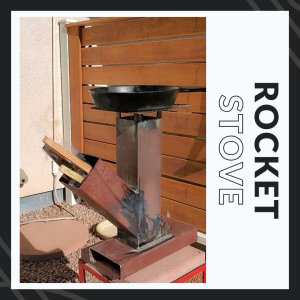 What is a Rocket Stove
What is a Rocket Stove
A rocket stove is a type of cooking stove that is designed to burn small pieces of wood or other biomass efficiently and with minimal smoke. It is called a “rocket” stove because the combustion process produces a strong, focused flame that resembles a rocket engine.
The design of a rocket stove typically consists of a combustion chamber, a vertical chimney, and a horizontal fuel magazine or feed tube. The fuel, such as small sticks or twigs, is placed into the fuel magazine and ignited. The flame travels up the chimney, creating a strong draft that pulls air into the combustion chamber and ensures efficient burning.
Rocket stoves are known for their high thermal efficiency, meaning they convert a large portion of the fuel’s energy into heat. The efficient combustion process results in less smoke and emissions compared to traditional open fires or less efficient stoves. Rocket stoves are often used for cooking and heating in areas where firewood or biomass is the primary source of fuel, especially in developing countries or off-grid settings.
Why Build a Rocket Stove
The advantages of rocket stoves include their fuel efficiency, reduced smoke and pollution, and the ability to use small pieces of wood or biomass, which are often readily available. They can be made from simple, inexpensive materials such as bricks, metal pipes, or even tin cans, making them accessible and affordable in many contexts. Rocket stoves have gained popularity as a sustainable and eco-friendly cooking solution in various parts of the world.
We build this stove from scrap metal around our home. The metal we used was a little thinner than we’d like but it’ what we had to work with. It was a great project for this part-time prepper and satisfying to see it come together in one afternoon. It’s now a part of our prepping tools.
Several groups of people might be interested in the topic of rocket stoves. Here are a few examples:
- Outdoor enthusiasts and campers: Rocket stoves are compact, portable, and efficient, making them an excellent cooking option for camping trips or outdoor adventures.
- Eco-conscious individuals: Those who prioritize sustainable living and reducing their carbon footprint may be interested in learning about rocket stoves as an eco-friendly cooking solution.
- Off-grid dwellers: People living in off-grid or remote areas, where access to electricity or traditional cooking fuels may be limited, can benefit from the efficiency and affordability of rocket stoves.
- Humanitarian and development organizations: NGOs and agencies working in communities with limited resources or in disaster-prone areas often promote the use of rocket stoves as a clean and efficient cooking solution.
- Sustainable technology enthusiasts: Individuals interested in renewable energy, alternative cooking methods, and innovative designs may find rocket stoves intriguing due to their unique combustion principles and resource efficiency.
Ultimately, anyone seeking more sustainable and efficient cooking methods, whether for outdoor activities, emergency preparedness, or everyday use, could potentially find the topic of rocket stoves interesting and relevant.
How to build a rocket stove:
Building a rocket stove can be a fun and rewarding project. Here’s a basic step-by-step guide to help you get started:
Materials you’ll need:
- Steel or metal pipe (6-8 inches in diameter) for the combustion chamber and chimney
- Steel or metal plate for the stove’s base
- Insulating material (such as firebricks or clay) for the combustion chamber
- Tin cans or metal containers for the fuel magazine and air intake
- High-temperature mortar or clay mixture
- Gravel or small stones (for stability and insulation)
- Tools (hacksaw, drill, hammer, pliers, etc.)
Step 1: Design and plan Decide on the size and dimensions of your rocket stove based on your needs. Sketch a rough design to help you visualize the structure and measurements.
Step 2: Prepare the combustion chamber Cut a section of the steel or metal pipe to serve as the combustion chamber. Attach the insulating material to the inner walls of the pipe using high-temperature mortar or clay. This helps retain heat and improve combustion efficiency.
Step 3: Create the chimney Cut another section of the pipe for the chimney. The length will depend on how tall you want your stove to be. Attach it vertically to the combustion chamber, leaving a small gap for airflow between the two pipes.
Step 4: Construct the base Place the steel or metal plate on a stable surface. This will serve as the stove’s base. You can also attach legs to raise the stove off the ground, if desired.
Step 5: Prepare the fuel magazine and air intake Cut a tin can or metal container to create the fuel magazine. This is where you’ll place the small pieces of wood or biomass for burning. Attach it horizontally to the combustion chamber, aligning it with the chimney. Cut another tin can to create an air intake pipe and attach it below the fuel magazine to provide oxygen for the combustion.
Step 6: Assemble the stove Using high-temperature mortar or clay, secure the components together, ensuring a tight and stable connection between the combustion chamber, chimney, fuel magazine, and air intake.
Step 7: Insulate the stove If desired, you can add additional insulation around the stove using clay, firebricks, or other insulating materials. This helps retain heat and improve efficiency.
Step 8: Test and use Allow the stove to dry and cure for a couple of days. To use the rocket stove, place small pieces of wood or biomass into the fuel magazine and light them. As the flame travels up the chimney, adjust the airflow through the air intake to control the heat intensity.
Remember to take necessary safety precautions when building and using the rocket stove, such as placing it on a non-flammable surface, keeping flammable materials away, and practicing fire safety.
Note: This is a basic guide, and there are variations in rocket stove designs. You can find detailed plans, tutorials, and videos online for different styles and modifications to suit your specific needs and preferences.
